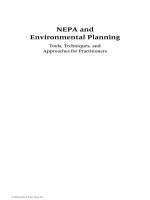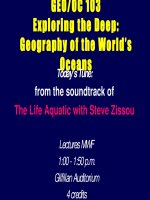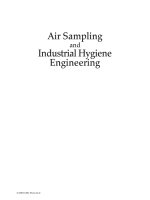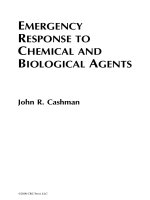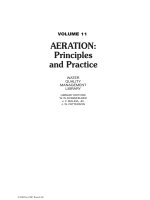AERATION: Principles and Practice ( VOLUME 11 ) - Chapter 1 ppsx
Bạn đang xem bản rút gọn của tài liệu. Xem và tải ngay bản đầy đủ của tài liệu tại đây (808.01 KB, 18 trang )
© 2002 by CRC Press LLC
AERATION:
Principles
and Practice
VOLUME 11
WATER
QUALITY
MANAGEMENT
LIBRARY
LIBRARY EDITORS
W. W. ECKENFELDER
J. F. MALINA, JR.
J. W. PATTERSON
© 2002 by CRC Press LLC
WATER QUALITY MANAGEMENT LIBRARY
The immense environmental challenges facing the world now and in coming
years can only be met through marshalling the talents of the best environmental
engineers and scientists and through the use of innovative, cost-effective
solutions.
The Water Quality Management Library addresses these challenges
and reflects the organized efforts of leading international experts. Collectively,
the eleven volumes in this library are a pertinent and timely compendium of
water pollution control and water quality management. They form a unique
reference source of international expertise and practice in key aspects of
modern water pollution science and technology. With such valuable
communication of knowledge using these and other books, we can hope to
overcome the critical environmental issues challenging us today.
Volume 1 ACTIVATED SLUDGE PROCESS DESIGN AND CONTROL:
Theory and Practice—Second Edition
Volume 2 UPGRADING WASTEWATER TREATMENT PLANTS—
Second Edition
Volume 3 TOXICITY REDUCTION: Evaluation and Control—
Second Edition
Volume 4 MUNICIPAL SEWAGE SLUDGE MANAGEMENT: A
Reference Text on Processing, Utilization and Disposal—
Second Edition
Volume 5 DESIGN AND RETROFIT OF WASTEWATER TREATMENT
PLANTS FOR BIOLOGICAL NUTRIENT REMOVAL
Volume 6 DYNAMICS AND CONTROL OF WASTEWATER
SYSTEMS— Second Edition
Volume 7 DESIGN OF ANAEROBIC PROCESSES FOR THE
TREATMENT OF INDUSTRIAL AND MUNICIPAL WASTES
Volume 8 GROUNDWATER REMEDIATION
Volume 9 NONPOINT POLLUTION AND URBAN
STORMWATER MANAGEMENT
Volume 10 WASTEWATER RECLAMATION AND REUSE
Volume 11 AERATION: Principles and Practice
CRC PRESS
Boca Raton London New York Washington, D.C.
AERATION:
Principles
and Practice
VOLUME 11
WATER
QUALITY
MANAGEMENT
LIBRARY
James A. Mueller, Ph.D., P.E.
William C. Boyle, Ph.D., P.E.
H. Johannes Pöpel, Dr Ing
LIBRARY EDITORS
W. W. ECKENFELDER
J. F. MALINA, JR.
J. W. PATTERSON
with significant contributions from:
Martin Wagner
David E. Gibson
Yeong-Kwan Kim
This book contains information obtained from authentic and highly regarded sources. Reprinted material
is quoted with permission, and sources are indicated. A wide variety of references are listed. Reasonable
efforts have been made to publish reliable data and information, but the authors and the publisher cannot
assume responsibility for the validity of all materials or for the consequences of their use.
Neither this book nor any part may be reproduced or transmitted in any form or by any means, electronic
or mechanical, including photocopying, microfilming, and recording, or by any information storage or
retrieval system, without prior permission in writing from the publisher.
The consent of CRC Press LLC does not extend to copying for general distribution, for promotion, for
creating new works, or for resale. Specific permission must be obtained in writing from CRC Press LLC
for such copying.
Direct all inquiries to CRC Press LLC, 2000 N.W. Corporate Blvd., Boca Raton, Florida 33431.
Trademark Notice:
Product or corporate names may be trademarks or registered trademarks, and are
used only for identification and explanation, without intent to infringe.
Visit the CRC Press Web site at www.crcpress.com
© 2002 by CRC Press LLC
No claim to original U.S. Government works
International Standard Book Number 1-56676-948-5
Library of Congress Card Number 2001052466
Printed in the United States of America 1 2 3 4 5 6 7 8 9 0
Printed on acid-free paper
Library of Congress Cataloging-in-Publication Data
Mueller, James A.
Aeration : principles and practice / James A. Mueller, William C. Boyle, H. Johannes
Pöpel ; with significant contributions from Martin Wagner, David E. Gibson,
Yeong-Kwan Kim.
p. cm. — (Water quality management library)
Includes bibliographical references and index.
ISBN 1-56676-948-5 (alk. paper)
1. Sewage—Purification—Aeration. I. Boyle, William C. (William Charles), 1936– II.
Pöpel, H. Johannes. III. Title. IV. Series.
TD758 .M84 2002
628.3
′
5—dc21 2001052466
CIP
Dedication
To our wives:
MaryBeth, Nancy, and Ursula
© 2002 by CRC Press LLC
© 2002 by CRC Press LLC
Preface
The use of aeration in the wastewater treatment field has been in existence for over
a century. Each of the authors has been involved with the theory and application of
aeration systems for a little less than half a century. It was a daunting task to put
together what we considered the important principles underlying the mechanisms
involved in aeration and show how they are applied in practical applications. The
objective was to not only provide the basic theory, but also the current practice and
latest applications, so the book would be useful to today’s professional engineers as
well as to future engineers now studying the field.
The task was conceived in the early 1990s by Wes Eckenfelder, who recognized
a gap in the field. After a number of false starts, and with Bill and I soliciting the
assistance of Johannes at the WEF convention in Chicago in 1997, it was begun in
earnest in 1998—taking several years to complete. Johannes supplied an in-depth
theoretical background as well as the European experience, especially in deep tank
aeration. Bill supplied his experience in the diffused aeration area, and his desire to
continually find the state of the art and how it is—and should be—practiced today.
I enjoyed tying the theory and practice together to attain a good understanding of
the most recent applications.
We received much assistance from our colleagues in the field. Especially noted
on the title page are those who spent a great deal of time and effort providing critical
input. They provided a needed jolt for each author to finish the endeavor by their
knowledge of the field, review of concepts, and critical editing when required.
I would especially like to mention the assistance of a number of former students
at Manhattan College. Richard Carbonaro scanned critical pictures while Rosanne
Schirtzer, Clayton Conklin, Kevin Clarke and Sue Hildreth dug into the economics
data from various agencies, a daunting task in itself. John Gormley, Engineering
Librarian at Manhattan, continually obtained needed references and ran critical
interference allowing me to ignore due dates.
The assistance of large municipal agencies in supplying critical information is
acknowledged. The New York City Department of Environmental Protection,
NYCDEP (especially Robert Adamski, John Leonforte, James G. Mueller (son),
Hilary Einsohn, and Siobahn Rohan), coordinated efforts to obtain cost information
on the New York City plants. The Metropolitan Water Reclamation District of Greater
Chicago, MWRDGC (especially Hugh McMillan), provided the latest developments
on the Chicago side channel aeration systems. The Middlesex County Utilities
Authority, MCUA (especially Victor Santamarina), supplied insights into their high
purity oxygen system upgrade.
Most of all I would like to thank God for giving us the energy and insights to
complete this book. I look forward to it continuing to shed light on the profession
and leading to the design and development of better aeration systems.
© 2002 by CRC Press LLC
The poem that follows was composed by Jim McKeown, a member of our
original oxygen transfer standards committee, who died of cancer in the winter of
1990–1991. It gives a bit of the history of the standards work, supported by the
USEPA and ASCE, that Bill and I were involved with since 1976. It is a reminder
that our work should never get the best of us—not above our relationships with each
other, and with our God.
James A. Mueller
© 2002 by CRC Press LLC
To the Study of the Drop and the Bubble
James J. McKeown
This is a poor story about
the dirty water band
who took to the field
when standardization was at hand.
After all, wasn’t it clear,
although the data wasn’t “purty,”
what was named the clean water test
was really very dirty.
The next step was upon us
it took only a spark of inspiration
for our band to begin the search
for the transfer of mass during respiration.
So we left the mainstream,
unfortunately, to no one’s real sorrow
to pursue our fair dream
in a breach where Whittier did Narrow.
The first results were so startling,
every possible relationship linear,
we had to move east—to avoid the critique—
our findings were true, but only in Califor-ni-a.
Where we could test
to avoid bias oracle;
where wastewater was
by all standards, categorical.
Who could argue with respiration, although lazy
extracted from sewage
undergoing renovation
in New Jersey?
Convinced by such rationale
supported by those seeking to prove
that if things aren’t quite right once
then they are always right when dual.
We joined the band within site
of sometime energetic Indian Point
where sometime aeration interfered
with our living in an otherwise elegant joint.
© 2002 by CRC Press LLC
Although we did proudly stand,
our bloom soon lost its peak
when
K
L
a escaped us
through an insidious leak.
Suitably humbled, we moved on
to further learn that
the non-steady test couldn’t be rushed
when for nearly 20 minutes all in Ridgewood
town, everyone, refused to flush.
Let’s not forget good can come from bad
for here in course bubbly, we examined off-gas.
And also, it can now be reported to superman’s value,
we corralled fair krypton here by switching from
plastic to glass.
Undaunted we moved on to finale grand
all planned to succeed where Miller had fallen
now was the time to again make our stand.
We would continue to search to stoop to
lower ourselves to the depths where oxygen did lurk
barely dissolved in such dirty water
that we even enlisted one we called daughter—uh
clerk.
But success was to come
from more than mere traces.
Rather, from working together
with methods as different
as different as the looks on our faces.
Now, you think we were done,
but an epilogue beckons.
Because this band, as a group
learned of martinis Cajun and riverboat soup,
not to mention, the proper way to eat grapefruit.
But most important, to leave some work undone
so we could meet once more
to march to the cadence and the lure
in search of a sponsor to help us continue to work
toward making dirty water—pure.
March 23, 1984
ASCE Oxygen Transfer Standards Committee
Coronado, California
© 2002 by CRC Press LLC
Table of Contents
Chapter 1
Introduction
1.1 Purpose
1.2 Intended Audience
1.3 Bibliography
Chapter 2
Principles
2.1 Mass Transfer Principles
2.2 Application to Oxygen Transfer
2.3 Design Equations
2.4 Nomenclature
2.5 Bibliography
Chapter 3
Diffused Aeration
3.1 Introduction
3.2 Description of Diffused Aeration Systems
3.3 Diffused Air System Layouts
3.4 Performance of Diffused Air Systems
3.5 Diffused Air System Design
3.6 Nomenclature
3.7 Bibliography
Chapter 4
Deep Tank Aeration with Blower and
Compressor Considerations
4.1 Introduction
4.2 Oxygen Transfer in Deep Tanks
4.3 Aeration Efficiency in Deep Tanks
4.4 Nomenclature
4.5 Bibliography
Chapter 5
Surface and Mechanical Aeration
5.1 Introduction
5.2 Low-Speed Surface Aerators
5.3 High-Speed or Motor Speed Aerators
5.4 Horizontal Rotors
5.5 Submerged Turbine Aerators
5.6 Aspirating Aerators
5.7 Factors Affecting Performance
5.8 Performance of Mechanical Aeration Devices
5.9 Design
5.10 Nomenclature
5.11 Bibliography
Chapter 6
High-Purity Oxygen Aeration
6.1 History
6.2 Covered Tank Systems
6.3 Open Tank Systems — Floating Cover
6.4 Nomenclature
6.5 Bibliography
Chapter 7
Testing and Measurement
7.1 Introduction
7.2 Aeration Tank Mass Balance
7.3 Clean Water Performance Testing
7.4 In-Process Oxygen Transfer Testing
7.5 Quality Assurance for Fine-Pore Diffusers
7.6 Characteristics of Diffused Air Materials
7.7 Nomenclature
7.8 Bibliography
Chapter 8
Aeration Systems in Natural Waters
8.1 Aeration — Streams and Rivers
8.2 Metropolitan Water District of Greater Chicago:
Full-Scale Instream Aeration Systems
8.3 Nomenclature
8.4 Bibliography
Chapter 9
Operation and Maintenance
9.1 Operation
9.2 System Monitoring
9.3 Aeration System Control
9.4 Maintenance — Diffused Air
9.5 Maintenance — Mechanical Aeration
9.6 Nomenclature
9.7 Bibliography
© 2002 by CRC Press LLC
© 2002 by CRC Press LLC
Introduction
1.1 PURPOSE
1.1.1 N
EED
AND
G
ROWTH
IN
F
IELD
At the beginning of the 20th century, activated sludge systems were developed into
an economically viable secondary treatment method. Aeration, used to transfer
oxygen to the biologically active masses of organisms within these systems, has
been an important part of wastewater treatment as the use of activated sludge
proliferated in the field. Significant changes have occurred in these systems as a
result of not only advances in technology but also variations in the cost of energy
required to operate them. The driving force of economics in some instances has
brought the technology used in older systems back to the forefront. Due to the
efficiency of power utilization, fine pore diffused aeration systems with full floor
coverage have been rediscovered as an outstanding example of this technology.
Different types of aeration systems have been employed in the field, depending
on location and specific treatment requirements. Large urban areas, where land is
at a premium, have tended to use high rate systems. In contrast, areas that are more
rural have used lower rate systems, generally requiring less operator involvement.
The requirements for increased nutrient removal and better effluent quality have
fostered the growth of systems that now incorporate not only the typical
aerobic
regions in aeration
tanks, but the anaerobic and anoxic regions as well. Thus,
numerous types of activated sludge systems have been developed to incorporate
these different demands. These include deep tank aeration, high-purity oxygen,
carousel or racetrack systems, anaerobic selector, and biological nutrient removal
systems that attain nitrification and denitrification in different sections of the same
tank. The basic principles governing the transfer of oxygen into the aerobic portion
of these aeration systems are similar for all applications.
The impact of aeration systems on plant capital and operating costs is one
measure of the importance of this unit operation to wastewater treatment. Table 1.1
summarizes the capital and operating costs of the aeration systems as a fraction of
total plant costs. These costs were obtained for a number of plants in the New York
metropolitan area, as well as a plant in Seattle, Washington, and one in Darmstadt,
Germany. The date of the plant capital costs is given at substantial plant completion
when secondary treatment is begun. Many of the contracts are written on a multiyear
basis, sometimes spanning 10 to 20 years, especially for the large New York plants
being upgraded. Construction of the Red Hook plant, a new facility, was begun in
1982 and completed in 1989 with secondary treatment on line in 1988.
Based on Table 1.1, the capital costs for aeration systems are typically between
15 and 25 percent of the construction costs for the total treatment plant. The
exception to this statistic is the relatively low 5.57 percent aeration capital costs for
1
© 2002 by CRC Press LLC
the North River plant in New York City. This plant, located in upper Manhattan, has
two additional major construction costs associated with it. One is construction of
the plant on piles over the Hudson River, and the other is the park constructed on
top of the plant for use by local residents. The costs of the Coney Island and Owls
Head plants include a complete plant upgrade, during which the facility maintained
operations. This scenario is typically more costly than new plant construction. Due
to the proximity of the local population, as in many New York plants, the Coney
Island costs include covered tanks for all but the secondary clarifiers and a scrubber
system to capture and treat air emissions before discharge.
TABLE 1.1
Impact of Aeration Systems on Activated Sludge Treatment Plant Costs
Plant
Name Location
Design
Flow,
m
3
/s
(MGD)
Type
Aeration
System
Capital Costs
Yearly Operating Costs
Reference
Total
Plant
10
6
$
(year)
% Due
to
Aeration
Total Plant
10
6
$/yr
(year)
% Due to
Aeration
Coney
Island
Brooklyn,
NY
4.4
(100)
Diffused,
fine pore
650
(1990)
20 4.43
(1998)
4.05
(1999)
20.1–25.5
*
20.3–25.2
*
(Conklin,
2001)
North
River
Manhattan,
NY
7.5
(170)
Diffused,
fine pore
968
(1986)
5.57 7.12
(1998)
7.43
(1999)
15.7
16.8
(Conklin,
2001;
Leonforte,
1998)
Red Hook Brooklyn,
NY
2.6
(60)
Diffused 232
(1988)
16.8 2.49
(1998)
2.29
(1999)
25
24
(Conklin,
2001;
Leonforte,
1998)
Owls
Head
Brooklyn,
NY
5.3
(120)
Diffused 380
(1995)
27 7.15
(2000)
17 (Clarke,
2001)
West
Point
Seattle,
WA
5.8
(133)
High
purity O
2
•surface
•4 stage
229
(1995)
19.3 (Hildreth,
1999;
Hildreth, et al.
1997)
MCUA Sayreville,
NJ
6.5
(147)
HPO
•turbine
•surface
95.5
(1974)
+8.9
(1995)
19.3
100
Upgrade
16.4 (1997)
15.2
(1999)
19.5
before
13
after
upgrade
(Schirtzer,
2000)
Darmstadt
Central
Germany 0.46
(10)
Diffused,
fine tubes
with
propellers
•racetrack
95
(1995)
15 3.4
(1997)
11.4 (Poepel,
2001;
Wacker,
1998)
* Including air scrubbers.
© 2002 by CRC Press LLC
Operation costs for aeration in treatment plants typically account for 15 to
25 percent of the total plant operational costs including labor and chemical use. The
energy consumed at the Coney Island plant by the blowers is 40 percent of the total
energy, the remainder due to the numerous pumping systems and air scrubbers at
the plant. For the high purity oxygen system in the Middlesex County Utility
Authority (MCUA) plant in New Jersey, operational costs for aeration were reduced
significantly from 19.5 percent of total costs to 13 percent after upgrading from
turbine to surface aeration. A significant reduction in power demand occurred with
the elimination of the large recirculating compressors and the cryogenic oxygen
generation facility. A pipeline oxygen source was economically feasible and allowed
simpler operation and maintenance with lower labor requirements for the treatment
plant. Total operational costs for this facility are high due to the significant costs for
sludge disposal after cessation of ocean dumping. Figures 1.1 and 1.2* illustrate the
FIGURE 1.1
Original submerged turbine system for MCUA plant showing aeration tank
turbine drives (A), gear reducer (B), high purity oxygen delivery piping (C) and compressor
room (D). (Photos courtesy of Middlesex County Utilities Authority, Sayreville, New
Jersey.)
* Figures 1.1 and 1.2 also appear in the color insert following page 84.
A
B
© 2002 by CRC Press LLC
differences in equipment requirements of the MCUA plant before and after upgrade
to surface aeration (Schirtzer, 2000).
Costs due to aeration at the relatively simple racetrack system used in Darmstadt,
Germany are only 11.4 percent of the operational costs. The capital and operating
costs are high for such a small plant compared with the larger facilities in the U.S.
This is due in part to economy of scale and to the higher degree of treatment obtained
by the plant, which discharges into a small creek. The per-cubic-meter sewer charge
for the contributing population is the second highest in Germany.
In addition to the wastewater treatment plants, where aeration systems have been
employed historically, new applications of aeration systems are being used in the
natural environment. Typically, these are used to improve dissolved oxygen concen-
trations to desired levels in natural waters where the demand for oxygen is greater
than can be supplied by natural reaeration. These applications have the same basic
principles governing the transfer of oxygen as those used in plant aeration systems.
In order to effectively incorporate the principles governing the design and analysis
of aeration systems into this myriad of applications, an understanding of the basic
principles involved in oxygen transfer is required. However, along with the principles,
FIGURE 1.1 (continued)
C
D
© 2002 by CRC Press LLC
the actual practice in the different applications is desirable to provide the field with
a useful product.
This book incorporates the approach of presenting the basic theory behind
aeration processes and then providing specific applications to several processes and
types of systems used in the field.
1.1.2 L
ONG
-T
ERM
I
NVOLVEMENT
OF
ASCE C
OMMITTEE
A significant portion of the material and work conducted for this book was developed
during the authors’ involvement with the American Society of Civil Engineers
(ASCE) committee on Oxygen Transfer Standards. This committee, composed of
numerous practitioners in the aeration field from around the world, was started in
1976 with the initial purpose of developing a standard for the testing of aeration
equipment in clean water. A number of conferences were held and reports generated
not only to develop the state of the art in clean water testing but also to extend the
testing techniques to process (dirty) water. With the financial assistance of the
FIGURE 1.2
(A) New surface aeration system for MCUA plant showing (B) compact surface
aeration drives, (C) with elimination of most overhead piping, and (D) elimination of most
equipment from compressor room. (Photos courtesy of Middlesex County Utilities Authority,
Sayreville, New Jersey.)
A
B
© 2002 by CRC Press LLC
USEPA, the work of the committee was extended to include design applications as
well as full-scale testing at various sites throughout the U.S. The many reports
already developed by this committee, as well as the ongoing work to continually
reevaluate and upgrade the state of the art in aeration testing, have supplied a
significant portion of the background material for this endeavor.
1.1.3 S
UMMARIZE
S
TATE
OF
THE
A
RT
IN
O
NE
L
OCATION
This book is intended to summarize, in one location, the state of the art in aeration
principles and practice. The numerous reports available from the above committee
as well as the ever-changing body of technical literature in the field are incorporated
into this work to show present practice.
Diffused air systems are considered in detail due to their present predominance in
the field, with mechanical aeration systems providing the breadth of use. To minimize
land area requirements in industries and metropolitan areas, experiences with deep
tank aeration are presented along with their impacts on the equipment required for air
supply. Design applications with both U.S. practice and European experience are
included along with testing techniques to evaluate performance. For high rate systems,
the oxygen transfer principles to describe high purity oxygen aeration are developed
FIGURE 1.2 (continued)
C
D
© 2002 by CRC Press LLC
along with the current application. Finally, use of constructed aeration systems in
natural waters is evaluated due to recent full-scale applications in rivers.
1.2 INTENDED AUDIENCE
Professionals involved in the design and analysis of aeration systems should find
this book a primary resource to understand and effectively evaluate various alterna-
tives based on a consistent set of principles. It is also aimed at the academic
profession, both students and professors, since the principles involved in aeration
are fully developed to allow application to practice. Various examples applying the
principles to design will be useful to both groups.
1.3 BIBLIOGRAPHY
Clarke, K. (2001). “Treatment Plant Costs for Owls Head NYC Water Pollution Control
Facility.” Masters Degree Special Project, Department of Environmental Engineering,
Manhattan College, NY.
Conklin, C. (2001). “Development of Capital and Operating Costs for Three NYC Water
Pollution Control Plants—Coney Island, North River and Red Hook.” Masters Degree
Thesis, Department of Environmental Engineering, Manhattan College, NY.
Hildreth, S. B. (1999). “Aeration Capital Costs for West Point, Seattle WWTP.” Personal
communication, 13 Jan., 1999.
Hildreth, S. B., Finger, R. E., Hammond, R. R., and Daigger, G. T., (1997). “Full Scale High
Purity Oxygen Activated Sludge Performance at the West Point WWTP, Seattle,
Washington.”
WEFTEC ’97, 70th Annual Conference of the Water Environment
Federation
, Chicago, IL, 617–628.
Leonforte, J. P. (1998). Letter on NYC Wastewater Plant capital costs—4 Nov., 1998. Chief,
Division of Intergovernmental Coordination, Bureau of Environmental Engineering,
NYCDEP.
Pöpel, H. J. (2001). Personal communication breaking down costs of Darmstadt plant. Emails,
3–5 Feb., 2001.
Schirtzer, R. (2000). “Submerged Turbine Aeration Conversion to Surface Aeration—Middlesex
County Utility Authority (MCUA) Cost Data.” Masters Degree Special Topic,
Department of Environmental Engineering, Manhattan College, NY.
Wacker, J. (1998). Fax to H. Johannes Pöpel with costs information on Darmstadt Central
Treatment Plant, Germany on 17 Mar., 1998.

